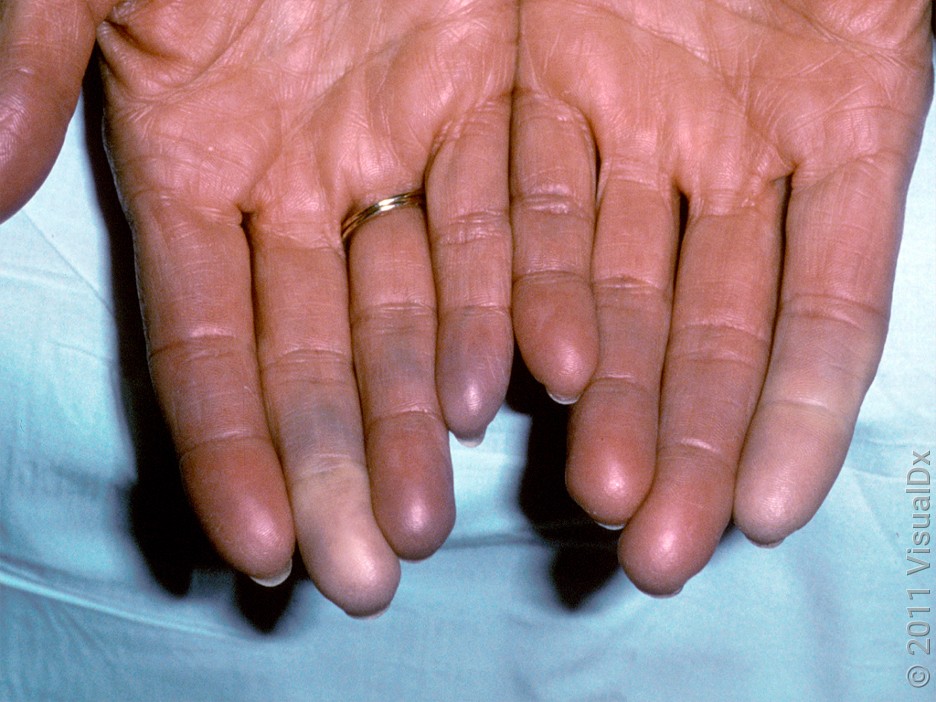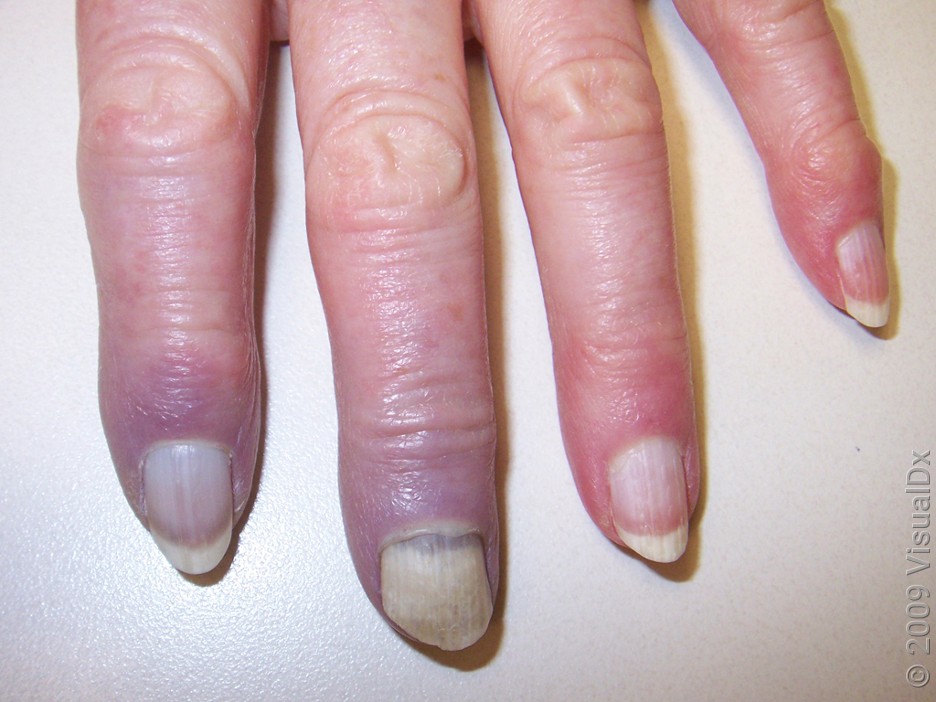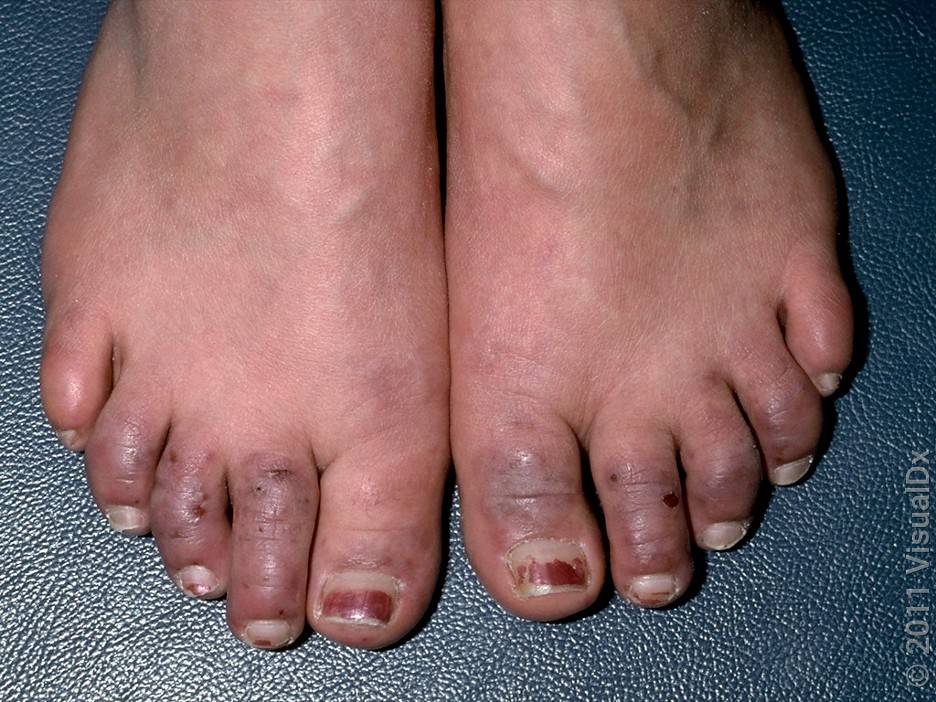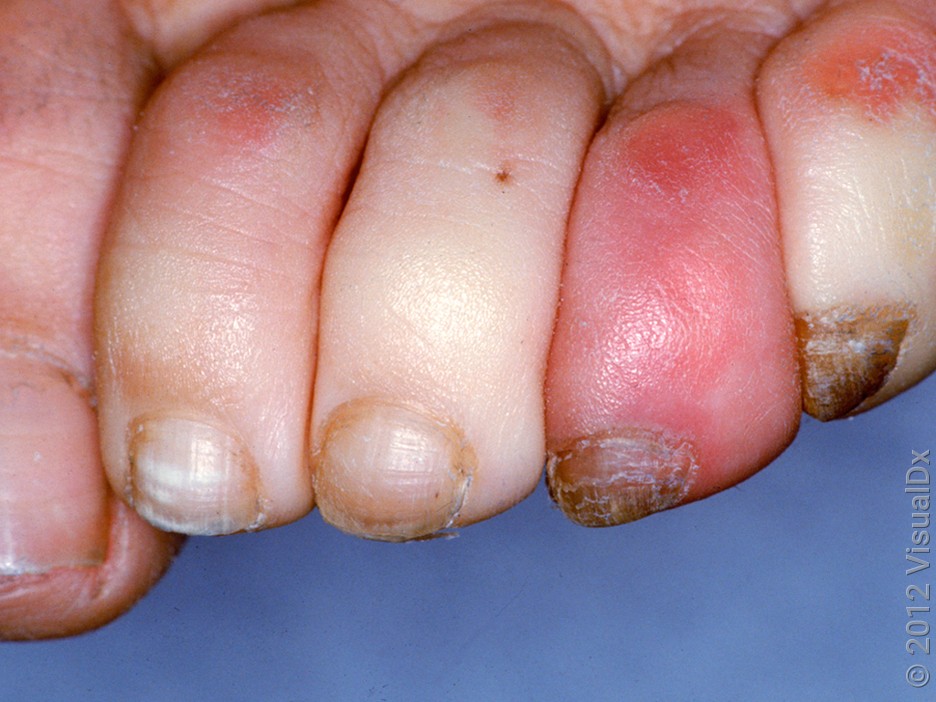
What Is Raynaud's Phenomenon? Symptoms, Causes, and Treatment (With Pictures)
Key takeaways:
Raynaud’s phenomenon is a spasm of blood vessels in the fingers and toes that leads to pain and color changes in the skin.
Raynaud’s can be an isolated condition, not related to any other medical problems. It can also be related to autoimmune disorders, certain medications, or blood conditions.
Treatment for Raynaud’s often includes lifestyle changes to avoid common triggers, like exposure to the cold. But there are also medications that can help.

Raynaud’s phenomenon (also known as Raynaud’s disease or Raynaud’s syndrome) occurs when there’s decreased blood flow to the fingers and sometimes toes, too. This can cause pain or tingling as well as changes in skin color.
Raynaud’s phenomenon usually happens after exposure to the cold. But it can also happen with stress and emotional triggers.
Let’s take a closer look at the causes and symptoms of Raynaud’s phenomenon (with images), how it’s treated, and some potential complications associated with the condition.
What are the symptoms of Raynaud’s syndrome?
Symptoms of Raynaud’s syndrome include pain, tingling, and changes in skin color, most commonly in the fingers and toes. But sometimes ears, nose, or lips may also be involved. At first, only one finger or toe may be affected. But then others may become involved.
Symptoms usually progress in this order:
Skin turns pale or white from decreased blood flow.
The area turns blue and can feel cold and numb.
As blood flow returns, the area may turn red, violet, or brown. And it can tingle, burn or throb.
Symptoms can last for a few minutes or up to a few hours. When Raynaud’s syndrome is severe, it can lead to painful sores or even tissue death (called gangrene).
Pictures of Raynaud’s syndrome
Here are some pictures of Raynaud’s syndrome in the fingers and toes to help you know what to look for.




Why does Raynaud's phenomenon happen?
Raynaud’s phenomenon happens when small blood vessels in the hands and feet suddenly spasm and narrow. Think of how a calf muscle can cramp or tighten up. The same thing happens to the walls of blood vessels with Raynaud’s. This tightness narrows the blood vessel, which decreases the amount of blood and oxygen reaching the tips of the fingers. The lack of oxygen is what leads to changes in skin color as well as pain and numbness.
These episodes usually happen after specific triggers. The most common trigger is exposure to cold, like:
Cold weather
Reaching into a freezer
Cold-water activities
Raynaud’s treatment: Learn more about the ways to treat and prevent Raynaud’s attacks.
Autoimmune conditions and Raynaud’s: Having an autoimmune condition can make it more likely for you to develop Raynaud’s phenomenon.
Ways to quit smoking: Smoking can increase the risk of Raynaud’s. Find out how to quit.
But Raynaud’s symptoms can also occur during times of stress and heightened emotion.
What causes Raynaud's disease?
Raynaud’s disease is categorized into two types: primary and secondary.
Primary Raynaud’s
Primary Raynaud’s is when the condition isn’t a result of a disease or medical problem. Though it’s not exactly clear what causes primary Raynaud’s, experts have identified some risk factors:
Being of the female sex
History of migraines
Cardiovascular disease
A family history of Raynaud’s syndrome
Secondary Raynaud’s
Secondary Raynaud’s means that the phenomenon is linked to an underlying condition. These are conditions that can affect blood flow and blood vessels in different ways, leading to the symptoms of Raynaud’s. Some examples include:
Thyroid conditions
Blood disorders (like cryoglobulinemia)
How is Raynaud’s syndrome diagnosed?
Doctors and other healthcare professionals usually diagnose Raynaud’s syndrome based on the symptoms that develop with cold exposure. They may also do additional tests, like:
Blood tests: These are used to see if there’s a secondary condition causing Raynaud’s (like lupus).
Nailfold capillaroscopy: With this test, a magnifier is used to look at the base of the fingernails for changes in the tiny blood vessels (capillaries) often seen in secondary Raynaud’s.
What should you do if you have a Raynaud’s attack?
If you start having a Raynaud’s attack, quickly warming your hands and feet can help stop it. You can try:
Placing your hands or feet in warm (not hot) water
Placing your hands or feet in another warm area (like placing your hands under your armpits).
Using a heating pad.
If these measures don’t help, talk to a healthcare professional for additional treatment options.
How can you prevent Raynaud's phenomenon from happening?
The first step in treating Raynaud’s phenomenon is to avoid any triggers or reduce risk factors whenever possible. This may include:
Keeping fingers and toes warm in cold weather
Quitting smoking
Lowering stress levels, even if it’s as simple as taking a few deep breaths in stressful situations
Reducing any medications that can cause decreased blood flow (such as pseudoephedrine, triptans for migraine headaches, and amphetamines, like Ritalin)
Exercising regularly to improve circulation
Avoiding sudden changes in temperature
Avoiding too much caffeine
How do you treat Raynaud’s syndrome?
The lifestyle changes mentioned above are typically the first choice of treatment for Raynaud’s. If these changes don’t significantly reduce the number of Raynaud’s episodes, a healthcare professional — usually a rheumatologist — can prescribe a variety of medications, such as:
Calcium channel blockers (CCBs) — the most commonly prescribed medication for Raynaud’s
Phosphodiesterase type 5 inhibitors (PDE5 inhibitors)
Treatments for primary vs. secondary Raynaud’s
Treatment for both primary and secondary Raynaud’s tends to overlap in a lot of cases and includes reducing exposure to known triggers.
But treatment for secondary Raynaud’s is aimed at both reducing the symptoms of Raynaud’s episodes, as well as treating the underlying condition.
Can Raynaud's be cured?
No, Raynaud’s phenomenon can’t be cured. But the symptoms can be managed with lifestyle modifications and medications. This can help to decrease both the frequency of Raynaud’s attacks and the severity.
How serious is Raynaud's disease?
You can’t die from Raynaud’s. But untreated attacks may lead to complications. Most Raynaud’s episodes usually resolve quickly and don’t cause serious issues. But, on rare occasions, complications can occur if there’s prolonged lack of oxygen to the tips of fingers and toes.
Without oxygen for several hours, the skin at the tips of fingers and toes can start to die. This can lead to sores and ulcers. These sores are then at risk for infection. These types of infections can be serious and require aggressive treatment with antibiotics.
If the infection isn’t treated, fingers and toes may need to be amputated in the most severe cases. But this is extremely rare. And it’s preventable when the sores and infections are treated early. If you start to notice some sores, see your primary care provider before they develop into something more serious.
Can Raynaud's cause blood clots?
Many people worry that Raynaud’s can lead to blood clots. Primary Raynaud’s isn’t commonly associated with blood clots. Secondary Raynaud’s is sometimes associated with blood clots, but this is often because the underlying disorder that leads to the Raynaud’s also increases the risk for blood clots. It isn’t the Raynaud’s itself that caused the blood clot.
Frequently asked questions
No, in general, Raynaud’s syndrome doesn’t affect life expectancy. However, if Raynaud’s syndrome is associated with certain serious underlying conditions — as in secondary Raynaud’s — those conditions may lower life expectancy.
Primary Raynaud’s is more likely to develop in women and people younger than the age of 30. It’s also more common in people with a family history of it.
Raynaud’s disease itself isn’t an autoimmune disease. But it could be a sign of an underlying autoimmune disease. So, it’s important to get the right diagnosis from a healthcare professional.
The bottom line
Raynaud’s is a fairly common condition that leads to temporary lack of blood flow to the fingers and, less commonly, toes. Even though it can be scary and painful, most episodes resolve quickly. There are simple changes that you can make to help prevent these episodes, like making sure you have warm gloves in the winter. But, if these steps don’t work, there are medications that can help, too. If you’re concerned about your Raynaud’s, talk to a healthcare professional and see how they can help.
Why trust our experts?



Images used with permission from VisualDx (www.visualdx.com).
References
American College of Rheumatology. (2023). Raynaud’s phenomenon.
Garner, R., et al. (2015). Prevalence, risk factors and associations of primary Raynaud's phenomenon: Systematic review and meta-analysis of observational studies. BMJ Open.
Hughes, M., et al. (2016). Raynaud’s phenomenon. Best Practice & Research Clinical Rheumatology.
MedlinePlus. (2023). Gangrene.
National Health Service. (2023). Raynaud’s.
National Institute of Arthritis and Musculoskeletal and Skin Diseases. (2024). Raynaud’s phenomenon.
National Institute of Arthritis and Musculoskeletal and Skin Diseases. (2024). Raynaud’s phenomenon: Diagnosis, treatment, and steps to take.
Nietert, P. J., et al. (2015). Raynaud phenomenon and mortality: 20+ years of follow-up of the Charleston Heart Study cohort. Clinical Epidemiology.


